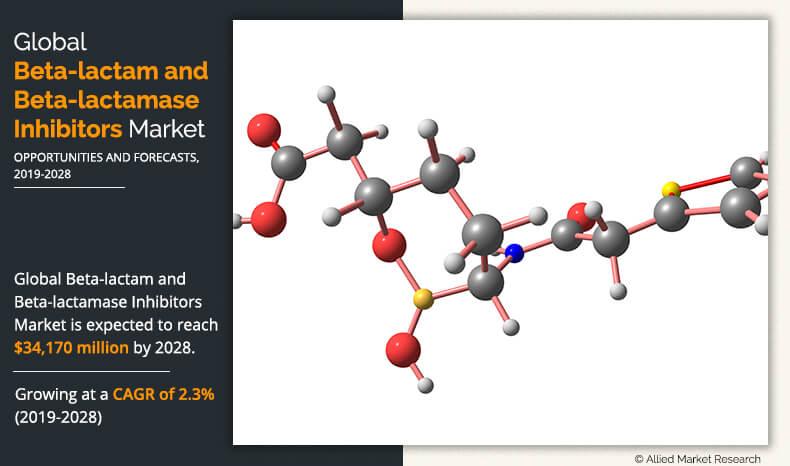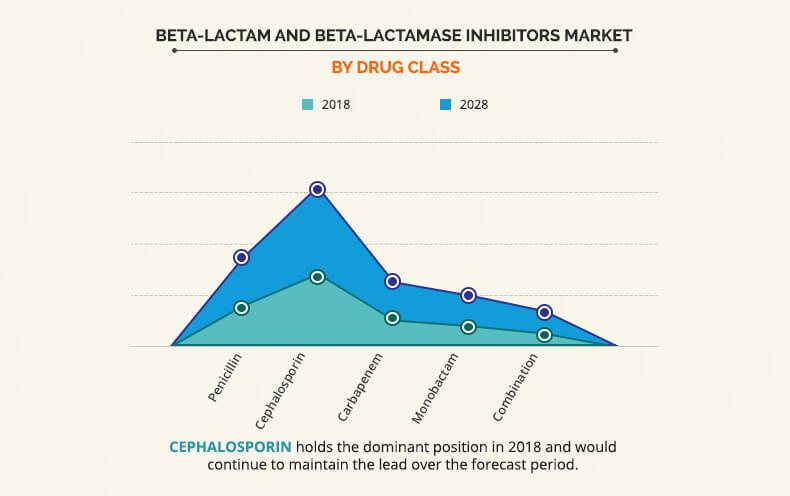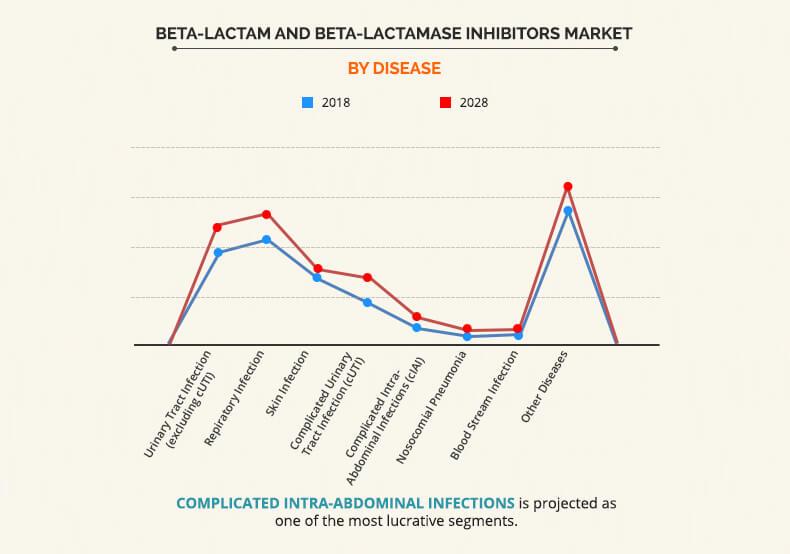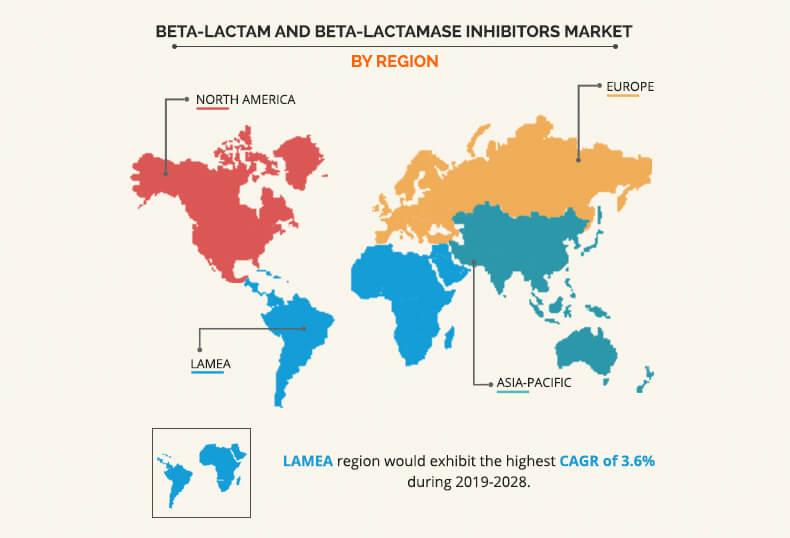Beta-lactam and Beta-lactamase Inhibitors Market Outlook - 2028
The global beta-lactam and beta-lactamase inhibitors market size was $27,126 million in 2018, and is projected to reach $34,170 million by 2028, growing at a CAGR of 2.3% from 2019 to 2028.
Beta-lactam antibiotics are a class of antibiotics consisting of all antibiotic agents that contain a beta-lactam ring in their molecular structures. This includes penicillin derivatives, cephalosporins, monobactams, and carbapenems. These are the antimicrobial substances or compounds that fight against bacterial infections and sometimes with protozoan infections. In addition, these medications either kill the bacteria directly or stop the bacteria from growing. However, these drugs are easily available at over-the-counter (OTC) and one can buy these without a prescription in most of the countries, which leads to overuse or misuse. Thereby, bacterial resistance is developing the beta-lactam antibiotics. Beta-lactamase enzymes are produced either constitutively or on exposure to antimicrobials. These enzymes break the beta-lactam ring of vulnerable penicillin & cephalosporin and inactivating the antibiotic to work against bacteria. Hence, beta-lactamase inhibitors are used in combination with the beta-lactam. Beta-lactamase inhibitors are a class of medicine that block the activity of beta-lactamase enzymes and prevent the degradation of beta-lactam antibiotics. Furthermore, there are many new drugs in the pipeline, which are expected to be launched during the forecast period and will create an opportunity for the global beta-lactam and beta-lactamase inhibitors market players.
The growth of the global beta-lactam and beta-lactamase inhibitors market is driven by increased consumption in low- and middle-income countries (LMICs) and rise in prevalence of infectious diseases. In addition, development of novel approaches for new beta-lactam and beta-lactamase inhibitors for treating bacterial infections and a large number of clinical trials further drive the market growth. However, development of antibiotic resistance, driven by misuse of beta-lactam and beta-lactamase inhibitors and the time taken for the regulatory approval is projected to impede the market growth. On the contrary, discovery of advanced prospect molecules and novel combination therapies to treat antibiotic-resistant microbial infections are expected to offer significant profitable opportunities for the market players and hence increases the beta-lactam and beta-lactamase inhibitors market share.
Drug class segment review
Based on the drug class, the market is classified into penicillin, cephalosporin, carbapenem, monobactam, and combination. Combination segment is further categorized into penicillin/beta lactamase inhibitors, cephalosporins/beta lactamase inhibitors, and carbapenems/beta lactamase inhibitors. The cephalosporin segment was the major revenue contributor in 2018, and is anticipated to continue this trend during the beta-lactam and beta-lactamase inhibitors market forecast period. This is attributed to its broad-spectrum activity and development of the next-generation cephalosporin, which can fight against antimicrobial resistance. In addition, it heals infections caused due to multiple groups of bacteria. Thus, the demand for cephalosporin is high among the healthcare providers and patients, which in turn fuels the growth of the global market.
Disease segment review
Depending upon the disease segment, the market is divided into urinary tract infection (excluding cUTI), respiratory infection, skin infection, complicated urinary tract infection (cUTI), complicated intra-abdominal infections (cIAI), nosocomial pneumonia, blood stream infection, and other diseases. The nosocomial pneumonia segment is further divided into hospital acquired pneumonia, ventilator associated pneumonia, and other nosocomial pneumonia. The cIAI segment is projected to exhibit the highest growth during the forecast period. This is attributed to the increase in burden of sepsis and rapid rise in mortality rate with greater disease severity across the world; and cIAI is one the most common cause of severe sepsis. In addition, complicated IAI extends beyond the source organ into the peritoneal space which causes peritoneal inflammation. Moreover, the mortality rate in severe IAIs are significantly high, which in turn increases the demand for novel drugs and boosts the growth of the beta-lactam and beta-lactamase inhibitors market.
Region segment review
Region wise, the beta-lactam and beta-lactamase inhibitors market is analyzed across North America, Europe, Asia-Pacific, and LAMEA. LAMEA is projected to exhibit the highest growth during the forecast period, owing to the easy obtainability of beta-lactam and beta-lactamase inhibitors over-the-counter as well as there are no legislation or restrictions on their use in this region. However, Asia-Pacific was the leading revenue contributor to the global beta-lactam and beta-lactamase inhibitors market in 2018, and is expected to remain dominant throughout the forecast period, due to increase in consumption of beta-lactam and beta-lactamase inhibitors, easy availability of these drugs, and rise in sale of beta-lactam and beta-lactamase inhibitors without prescription.
The report provides a comprehensive beta-lactam and beta-lactamase inhibitors market analysis of the key players operating in the global beta-lactam and beta-lactamase inhibitors market, namely, Abbott Laboratories, Allergan Plc., F. Hoffmann-La Roche Ltd., GlaxoSmithKline plc, Merck & Co. Inc., Mylan N.V., Novartis International AG (Sandoz), Pfizer Inc., Sanofi, and Teva Pharmaceutical Industries Ltd. The other players in the value chain include Hikma Pharmaceuticals, Melinta Therapeutics, Eli Lilly and Company, Shionogi, Inc., AstraZeneca plc, and others.
Key Benefits for Beta-lactam and Beta-lactamase Inhibitors Market:
- This report provides a detailed quantitative analysis of the current beta-lactam and beta-lactamase inhibitors market trends and estimations from 2018 to 2028, which assists to identify the prevailing opportunities.
- An in-depth market analysis of various regions is anticipated to provide a detailed understanding of the current trends to enable stakeholders formulate region-specific plans.
- A comprehensive analysis of the factors that drive and restrain the beta-lactam and beta-lactamase inhibitors market growth of the market is provided.
- Region-wise and country-wise market conditions are comprehensively analyzed in this report.
- The projections in this report are made by analyzing the current trends and future market potential from 2019 to 2028 in terms of value.
- An extensive analysis of various regions provides insights that are expected to allow companies to strategically plan their business moves.
- Key market players within the market are profiled in this report and their strategies are analyzed thoroughly, which helps to understand the competitive outlook of the global market.
Beta-lactam and Beta-lactamase Inhibitors Market Report Highlights
| Aspects | Details |
| By Drug Class |
|
| By Disease |
|
| By Route Of Administration |
|
| By Region |
|
| Key Market Players | Mylan N.V., Merck & Co. Inc., Novartis International AG (Sandoz), Teva Pharmaceutical Industries Ltd., Pfizer Inc., F. Hoffmann-La Roche Ltd., Allergan Plc., Sanofi, GlaxoSmithKline plc, Abbott Laboratories |
Analyst Review
The growth of the beta-lactam and beta-lactamase inhibitors market is expected to increase due to substantial investments in R&D activities by several biotech companies and favorable government legislations. In addition, increased consumption in low and middle-income countries (LMICs), rise in prevalence of infectious diseases, and development of novel approaches for new beta-lactam and beta-lactamase inhibitors for treating bacterial infections and a large number of clinical trials are projected to further drive the market growth during the forecast period. However, development of antibiotic resistance, driven by misuse of beta-lactam and beta-lactamase inhibitors and the increase in drug approval costs are expected to hinder the market growth.
Asia-Pacific is expected to remain dominant during the forecast period due to increase in consumption of beta-lactam and beta-lactamase inhibitors, cost of antibiotic is less, and high prevalence of bacterial infections in the developing countries. In addition, Asia-Pacific and LAMEA are expected to offer lucrative opportunities to the key players during the forecast period due to rise in antimicrobial resistance, which lead the pharmaceutical companies toward R&D of next generation beta-lactam and beta-lactamase inhibitors.
Loading Table Of Content...







